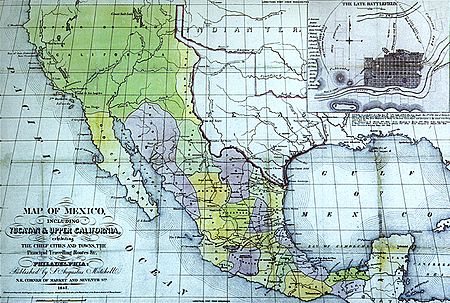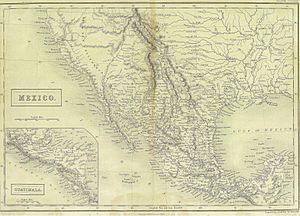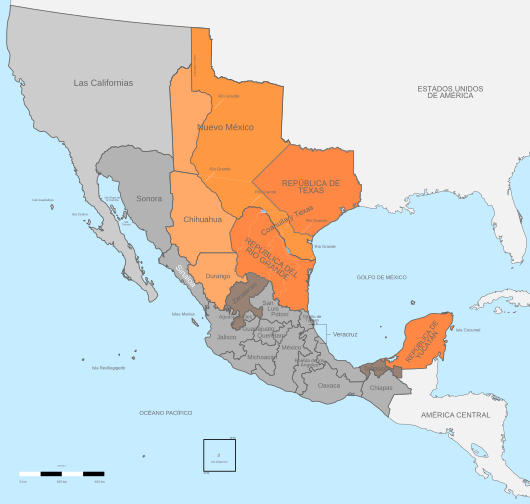Alta California facts for kids
Quick facts for kids Alta California |
|||||||||
|---|---|---|---|---|---|---|---|---|---|
| Province of the Viceroyalty of New Spain (1804–1821) Province of the First Mexican Empire (1821–1824) Federal Territory of Mexico (1824–1836) |
|||||||||
| 1804–1836 | |||||||||
 |
|||||||||
| Capital | Monterey (1804–1836) | ||||||||
| Demonym | Californio | ||||||||
| Government | |||||||||
| Governor | |||||||||
|
• 1804–1814
|
José Joaquín de Arrillaga (First Spanish governor) |
||||||||
|
• 1815–1822
|
Pablo Vicente de Solá (Last Spanish governor) |
||||||||
|
• 1822–1825
|
Luis Antonio Argüello (First Mexican governor) |
||||||||
|
• 1836
|
Nicolás Gutiérrez (Last Alta California governor) |
||||||||
| Historical era | Spanish colonial era | ||||||||
| 1769 | |||||||||
|
• Established
|
1804 | ||||||||
| August 24, 1821 | |||||||||
| January 13, 1847 | |||||||||
|
• Disestablished
|
1836 | ||||||||
|
|||||||||
| Today part of | United States
Mexico |
||||||||
Alta California ('Upper California'), also known as Nueva California ('New California'), among other names , was a province of New Spain, formally established in 1804. Along with the Baja California peninsula, it had previously comprised the province of Las Californias, but was split off into a separate province in 1804 (named Nueva California). Following the Mexican War of Independence, it became a territory of Mexico in April 1822 and was renamed Alta California in 1824. The claimed territory included all of the modern U.S. states of California, Nevada, and Utah, and parts of Arizona, Wyoming, Colorado, and New Mexico. In the 1836 Siete Leyes government reorganization, the two Californias were once again combined (as a single departamento). That change was undone in 1846, but rendered moot by the U.S. military occupation of California in the Mexican-American War.
Neither Spain nor Mexico ever colonized the area beyond the southern and central coastal areas of present-day California and small areas of present-day Arizona, so they exerted no effective control in modern-day California north of the Sonoma area, or east of the California Coast Ranges. Most interior areas such as the Central Valley and the deserts of California remained in de facto possession of indigenous peoples until later in the Mexican era when more inland land grants were made, and especially after 1841 when overland immigrants from the United States began to settle inland areas.
Large areas east of the Sierra Nevada and Coast Ranges were claimed to be part of Alta California but were never colonized. To the southeast, beyond the deserts and the Colorado River, lay the Spanish settlements in Arizona.
Alta California ceased to exist as an administrative division separate from Baja California in 1836, when the Siete Leyes constitutional reforms in Mexico re-established Las Californias as a unified department, granting it (in some ways) more autonomy. Most of the areas formerly comprising Alta California were ceded to the United States in the Treaty of Guadalupe Hidalgo that ended the Mexican–American War in 1848. Two years later, California joined the union as the 31st state. Other parts of Alta California also became all or part of the later states of Nevada, Utah, Arizona, Colorado, and Wyoming.
Contents
Spanish colonization
Between 1683 and 1834, Jesuit and Franciscan missionaries established a series of religious outposts from today's Baja California and Baja California Sur into present-day California. The cortes (legislature) of New Spain issued a decree in 1813 for at least partial secularization that affected all missions in America and was to apply to all outposts that had operated for ten years or more; however, the decree was never enforced in California. Father Eusebio Kino missionized the Pimería Alta from 1687 until his death in 1711. Plans in 1715 by Juan Manuel de Oliván Rebolledo resulted in a 1716 decree for extension of the conquest (of Baja California) which came to nothing. Juan Bautista de Anssa proposed an expedition from Sonora in 1737 and the Council of the Indies planned settlements in 1744. Don Fernando Sánchez Salvador researched the earlier proposals and suggested the area of the Gila and Colorado Rivers as the locale for forts or presidios preventing the French or the English from "occupying Monterey and invading the neighboring coasts of California which are at the mouth of the Carmel River." Alta California was not easily accessible from New Spain: land routes were cut off by deserts and often hostile Native populations and sea routes ran counter to the southerly currents of the distant northeastern Pacific. Ultimately, New Spain did not have the economic resources nor population to settle such a far northern outpost.
Spanish interest in colonizing Alta California was revived under the visita of José de Gálvez as part of his plans to completely reorganize the governance of the Interior Provinces and push Spanish settlement further north. In subsequent decades, news of Russian colonization and maritime fur trading in Alaska, and the 1768 naval expedition of Pyotr Krenitsyn and Mikhail Levashev, in particular, alarmed the Spanish government and served to justify Gálvez's vision.
The first Alta California mission and presidio were established by the Franciscan friar Junípero Serra and Gaspar de Portolá in San Diego in 1769. The following year, 1770, the second mission and presidio were founded in Monterey.
Spain also settled the California region with a number of African and mulatto Catholics, including at least ten of the recently re-discovered Los Pobladores, the founders of Los Angeles.
Spanish rule
By law, mission land and property were to pass to the indigenous population after a period of about ten years, when the natives would become Spanish subjects. In the interim period, the Franciscans were to act as mission administrators who held the land in trust for the Native residents. The Franciscans, however, prolonged their control over the missions even after control of Alta California passed from Spain to independent Mexico, and continued to run the missions until they were secularized, beginning in 1833. The transfer of property never occurred under the Franciscans.
As the number of Spanish settlers grew in Alta California, the boundaries and natural resources of the mission properties became disputed. Conflicts between the Crown and the Church and between Natives and settlers arose. State and ecclesiastical bureaucrats debated over authority of the missions. The Franciscan priests of Mission Santa Clara de Asís sent a petition to the governor in 1782 which stated that the Mission Indians owned both the land and cattle and represented the Ohlone against the Spanish settlers in nearby San José. The priests reported that Indians' crops were being damaged by the pueblo settlers' livestock and that the settlers' livestock was also "getting mixed up with the livestock belonging to the Indians from the mission" causing losses. They advocated that the Natives owned property and had the right to defend it.
In 1804, due to the growth of the Spanish population in new northern settlements, the province of Las Californias was divided just south of San Diego, following mission president Francisco Palóu's division between the Dominican and Franciscan jurisdictions. Governor Diego de Borica is credited with defining Alta (upper) and Baja (lower) California's official borders.
The Adams–Onís Treaty of 1819, between the United States and Spain, established the northern limit of Alta California at latitude 42°N, which remains the boundary between the states of California, Nevada and Utah (to the south) and Oregon and Idaho (to the north) to this day. Mexico won independence in 1821, and Alta California became a territory of Mexico the next year.
Ranchos
The Spanish and later Mexican governments rewarded retired soldados de cuera with large land grants, known as ranchos, for the raising of cattle and sheep. Hides and tallow from the livestock were the primary exports of California until the mid-19th century. The construction, ranching and domestic work on these vast estates was primarily done by Native Americans, who had learned to speak Spanish and ride horses. Unfortunately, a large percentage of the population of Native Californians died from European diseases. Under Spanish and Mexican rule the ranchos prospered and grew. Rancheros (cattle ranchers) and pobladores (townspeople) evolved into the unique Californio culture.
Independent Mexico
Mexico gained independence from Spain on August 24, 1821, upon conclusion of the decade-long Mexican War of Independence. As the successor state to the Viceroyalty of New Spain, Mexico automatically included the provinces of Alta California and Baja California as territories. Alta California declared allegiance to the new Mexican nation and elected a representative to be sent to Mexico. On November 9, 1822, the first legislature of California was created. With the establishment of a republican government in 1824, Alta California, like many northern territories, was not recognized as one of the constituent States of Mexico because of its small population. The 1824 Constitution of Mexico refers to Alta California as a "territory".
Resentment was increasing toward appointed governors sent from Mexico City, who came with little knowledge of local conditions and concerns. Laws were imposed by the central government without much consideration of local conditions, such as the Mexican secularization act of 1833, causing friction between governors and the people.
In 1836, Mexico repealed the 1824 federalist constitution and adopted a more centralist political organization (under the "Seven Laws") that reunited Alta and Baja California in a single California Department (Departamento de las Californias). The change, however, had little practical effect in far-off Alta California. The capital of Alta California remained Monterey, as it had been since the 1769 Portola expedition first established a military/civil government, and the local political structures were unchanged.
The friction came to a head in 1836, when Monterey-born Juan Bautista Alvarado led a revolt against the 1836 constitution, seizing control of Monterey from Nicolás Gutiérrez. Alvarado's actions nearly led to a civil war with loyalist forces based in Los Angeles, but a ceasefire was arranged. After an unsettled period, Alvarado agreed to support the 1839 constitution, and Mexico City appointed him to serve as governor from 1837 to 1842. Other Californio governors followed, including Carlos Antonio Carrillo, and Pío Pico. The last non-Californian governor, Manuel Micheltorena, was driven out after another rebellion in 1845. Micheltorena was replaced by Pío Pico, last Mexican governor of California, who served until 1846 when the U.S. military occupation began.
Mexican–American War
In the final decades of Mexican rule, American and European immigrants arrived and settled in the former Alta California. Those in Southern California mainly settled in and around the established coastal settlements and tended to intermarry with the Californios. In Northern California, they mainly formed new settlements further inland, especially in the Sacramento Valley, and these immigrants focused on fur-trapping and farming and kept apart from the Californios.

In 1846, following reports of the annexation of Texas to the United States, American settlers in inland Northern California took up arms, captured the Mexican garrison town of Sonoma, and declared independence there as the California Republic. At the same time, the United States and Mexico had gone to war, and forces of the United States Navy entered into Alta California and took possession of the northern port cities of Monterey and San Francisco. The forces of the California Republic, upon encountering the United States Navy and, from them, learning of the state of war between Mexico and the United States, abandoned their independence and proceeded to assist the United States forces in securing the remainder of Alta California. The California Republic was never recognized by any nation and existed for less than one month, but its flag (the "Bear Flag") survives as the flag of the State of California.
After the United States Navy's seizure of the cities of southern California, the Californios formed irregular units, which were victorious in the Siege of Los Angeles, and after the arrival of the United States Army, fought in the Battle of San Pasqual and the Battle of Domínguez Rancho. But the Californios were defeated in subsequent encounters, the battles of Río San Gabriel and La Mesa. The southern Californios formally surrendered with the signing of the Treaty of Cahuenga on January 13, 1847. After twenty-seven years as part of independent Mexico, California was ceded to the United States in 1848 with the signing of the Treaty of Guadalupe Hidalgo. The United States paid Mexico $15 million for the lands ceded.
Spanish governors
- 1804 – 25 July 1814 José Joaquín de Arrillaga
- 25 July 1814 – 15 August 1815 José Darío Argüello (acting)
- 15 August 1815 – 11 April 1822 Pablo Vicente de Solá
For Mexican governors see List of Governors of California before admission
Flags that have flown over California
 |
Spanish Empire, may have been flown by the Portuguese explorer Juan Rodríguez Cabrillo in 1542, upon entering the bay of San Diego, and by the Portolá expedition that founded the colony of Alta California in 1769. |
| St. George Cross of England, June 1579, voyage of the Golden Hind under Captain Francis Drake at Bodega Bay, Tomales Bay, Drakes Bay or Bolinas Bay (exact location disputed). | |
 |
October 1775, the Sonora at Bodega Bay, under Lt. Juan Francisco de la Bodega y Quadra until 1821, when New Spain gained independence from the Spanish Empire. |
 |
Russian-American Company, by Ivan Alexandrovich Kuskov, the founder of Fort Ross and, from 1812 to 1821, its colonial administrator. The Russian-American Company only controlled a small portion of the northern coast of California, while the entire territory was diplomatically recognized as territory of Mexico; this situation was terminated when the Russians sold Fort Ross in 1841 to John Sutter, and subsequently left the area in 1842. |
 |
On a ship from Argentina, by Hippolyte Bouchard, a French-born pirate who attacked Monterey Bay from November 24 to November 29, 1818, in order to annoy Spain, who ruled Argentina. Bouchard claimed California on behalf of Argentina, but this claim was never recognized, even by the Argentine government. |
| First Mexican Empire, August 24, 1821, Mexico under Emperor Agustín de Iturbide (October 1822, probable time new flag raised in California) until 1823. | |
| United Mexican States military, 1823, until January 13, 1847, at Los Angeles. | |
 |
Flag of California, for a few months in 1836, when Alvarado's coup declared independence from Mexico (the Declaration of Independence is available on Wikisource). |
 |
Bear Flag of the California Republic, June 14, 1846, at Sonoma until July 9, 1846. The California Republic was declared by American citizens who had settled inland (in the valley of the Sacramento and San Joaquin Rivers), and it is thought that the inclusion of one star and one stripe was meant to highlight their American origins. The Republic's existence was never officially recognized by any other government. |
| United States, July 9, 1846; see History of California. |
For even more Californian flags see:
See also
 In Spanish: Alta California para niños
In Spanish: Alta California para niños




